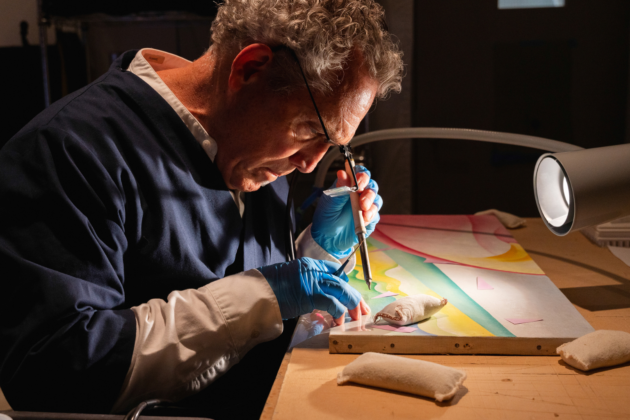
Finding Kimono Clues in Kamakura, Japan
When I began my internship at the Georgia O’Keeffe Museum I spent a lot of time looking around the galleries and thinking about what spoke to me personally. I related most to O’Keeffe’s collection of postcards and from her explorations around India, Southeast Asia, and Japan in the 1950’s. My collection of travel mementos help me to remember what vision of place I first went in search of when traveling. Postcards present idealized views of a place, well-engineered to hide the crowds that clutter tourist destinations; they are intended to remind us of the private feeling we had when seeing a monument or significant place.
A landscape painting can create a similarly undisturbed reality through the lens of the artist’s experience. In 1960, Georgia O’Keeffe painted two views of Fujisan in hues of pastel pink, each communicating a personal reflection on her journey to Japan. Untitled (Mt. Fuji), 1956 is an iconic profile of the serene snowy peak, standing alone against the fading hot pink sky. When I traveled with my family to Japan in June, I was hoping to see Mount Fuji in all its glory like O’Keeffe had. My chances were slim considering I chose to view Mt. Fuji from Kamakura, a nearby beach town which offers an average 90 days of visibility a year. During my visit to Kamakura I searched for ways in which O’Keeffe was impacted by the culture and land.

Georgia O’Keeffe
Oil on canvas
10 x 18 (25.4 x 45.7)
Georgia O’Keeffe Museum
Gift of Gerald and Kathleen Peters (1996.02.001)
© The Georgia O’Keeffe Museum
At the street markets in Kamakura I noticed groups of Japanese people, men and women, wearing lightweight, brightly decorated kimonos, complete with thong sandals and matching fabric bags. I did not expect to see locals dressed like this; I thought kimonos were strictly traditional formal wear. I was surprised to see that Wafuku (traditional Japanese clothing) are worn for weddings, work, and weekend shopping alike. This reminded me of the work I had been doing cataloging O’Keeffe’s vintage collection of kimonos. Working with the patterned silks has been the most fascinating part of my internship so far because I am constantly researching different kimono types and terminology. O’Keeffe’s interest in kimonos reflects the rest of her fashion aesthetic. Her wardrobe contained wide sleeves and draped robes, but it was from this traditional Japanese clothing that her go-to styles originated. I’ve worked with ten kimonos already. My fellow intern and I joked that O’Keeffe must have come back from Japan with a suitcase dedicated to kimonos! Her collection holds a variety of styles. The kuro-tomesode is the most formal in all black with five family crests or mon embroidered on the shoulders and back. She has some Haori, or waist length men’s kimono jackets, which are distinguished by their shorter, attached sleeves. She has several Yukata, a type of casual summer kimono in a lighter silk weave, which experienced a revival in the 1990’s. When I was visiting shrines and local markets in Kamakura I saw men and women shopping in these types of customary summer ensembles.
In Kamakura we saw one of the biggest Buddha sculptures in Japan nestled into the surrounding forest. The Great Buddha of Kotokuin Temple stands over 40 feet tall! In front of it incense burns continually and there are watermelons set as an offering at the foot of the statue. Downhill from Kotokuin Temple I stepped into a small vintage kimono store. I began looking through the racks and I found a tomesode kimono with this emblem on it that was similar to one I remembered seeing in O’Keeffe’s collection. The emblem embroidered on black silk has two white falcon feathers crossing in a circle. My research led me to understand that it belonged to the takanoha category. Variations of these takanoha crests are held by many families and it is an emblem often adopted by samurai. I brought the kimono to the front counter and tried to ask the employees if they knew about the particular mon it featured. With the help of another customer acting as my translator, I found out that the crest belonged to the family operating the vintage store! The information the store owners shared corroborated my own research of mon and gave me insight into where O’Keeffe may have purchased a kimono with a particular family emblem.
It was too cloudy for us to see past the shore that day in Kamakura, so I never saw Fujisan for myself. I was, however, able to better understand the captivating kimonos I have been cataloging this summer. I was intrigued to see people wearing kimonos around town; that experience helped me understand how kimonos are relevant today in Japanese culture. O’Keeffe was inspired by the customary costume she found in Japan, so much so that she tried to incorporate them it into her polished desert outfits. My trip helped me to understand the inspiration O’Keeffe must have felt 56 years ago when she visited Japan for the first time.
This post was written by Isabella Caporuscio, Registrar Intern, Georgia O’Keeffe Museum.


